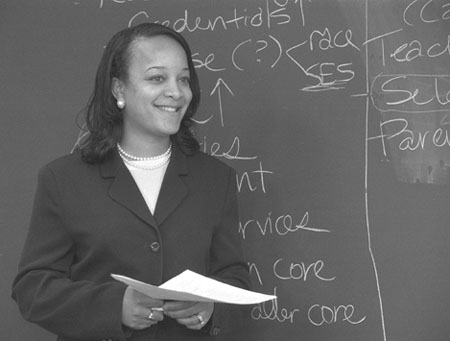The Long Road to College Access

Education professor Bridget Terry Long, poised with an economist’s training, is zeroing in on an education question that’s always intrigued her: What factors determine who goes to college and who does not?
Her own family’s divided history reveals the source of this question. Her parents came from a small, economically depressed Virginia town. Breaking with convention, they left, put themselves through college, and started careers. Many of their siblings stayed behind to take factory jobs. Long’s parents stressed education-that transformative opportunity that enabled them to lead successful, mobile lives. “I grew up wondering why them? Why do some people go to college and others don’t? And what accounts for the big differences in lifestyles that result from that?” says Long.
At age 27, Long, who is the youngest new faculty member at HGSE, has already proven a fierce dedication to the education process. A math whiz, she became interested in economics as a way to “get at the heart” of her questions and at the deeper social issues that underlie them. For her dissertation in economics at Harvard’s Faculty of Arts and Sciences, she created a statistical model for understanding how students weigh price or location in their college decisions. “In the end, my question is about access. And it’s about whether or not education, as a social policy, is really the solution to many of our nation’s problems.”
More than ever, policymakers now opt for merit-based, rather than need-based, financial aid programs, a trend that disquiets Long. In Georgia, for instance, a new state policy offers students with a B-average or higher free tuition at an in-state public college of their choice. Such plans are widely popular among voters, says Long, therefore they have cropped up in over 20 states.
“On the surface it sounds great,” says Long. “You want to make sure that any kid who does well in school gets to go to college for free. But the repercussions of the policies have been very different.”
Although the Georgia plan has cost $1.2 billion over the last seven years, it has only increased enrollment by about 100,000 students. That means that, in the end, 80 percent of the funds went to students who would have gone to college anyway. At the same time, the program boosted University of Georgia state schools’ average incoming SAT scores by about 100 points, making it more difficult for lower-scoring students to gain admission.
“In Georgia, the situation is such that more middle- to upper-class students get the money,” says Long, who traveled to West Virginia in March to try to dissuade legislators there from passing merit-based aid legislation. “If you want to increase access, this is not the way to do it,” she adds.
As an assistant professor at the Graduate School of Education, Long translates quantitative effects of policies like those in Georgia into ideas that raise public awareness of important issues. “Economists tend to speak to each other in this really high concept vocabulary. But you can’t talk that way with policymakers when they want to know if something will provide the most bang for their buck.”




